LiDAR Point Clouds Usage for Mapping the Vegetation Cover of the “Fryderyk” Mine Repository
Abstract
:1. Introduction
2. Methods
- ALS point clouds—two series: 2011 and 2019, parameters: 4 reflections as a minimum, 12 points/m2, altitude accuracy ≤ 0.15 m, situational accuracy ≤ 0.50 m; source: pl. ISOK Project—Informatics System of the Country Protection from Extraordinary Threat; Main Office of Geodesy and Cartography, Poland [24].
- Orthophotomaps: 2011 and 2019, GSD: 0.25 m, coordinates system: PL-PUWG1992, (ISOK Project [24]).
- Cadastral data (portals: WebEwid and Geoportal).
3. Results
4. Discussion
5. Conclusions
Author Contributions
Funding
Data Availability Statement
Conflicts of Interest
References
- Krzaklewski, W.; Pietrzykowski, M. Selected physicochemical properties of zinc and lead ore tailings and their biological stabilisation. Water Air Soil Pollut. 2002, 141, 125–142. [Google Scholar] [CrossRef]
- Krzaklewski, W.; Barszcz, J.; Małek, S.; Kozioł, K.; Pietrzykowski, M. Contamination of forest soils in the vicinity of the sedimentation pond after zinc and lead ore flotation (in the region of Olkusz, Southern Poland). Water Air Soil Pollut. 2004, 159, 151–164. [Google Scholar] [CrossRef]
- Pradela, A.; Solarski, M. Rozwój górnictwa rud cynku i ołowiu w bytomsko−tarnogórskim rejonie złożowym od końca XVIII wieku do czasów współczesnych. In Z Badań Nad Wpływem Antropopresji na Środowisko; Machowski, R., Rzętała, M., Eds.; Studenckie Koło Naukowe Geografów UŚ, Wydział Nauk o Ziemi UŚ: Sosnowiec, Poland, 2013; Volume 14, pp. 43–50. [Google Scholar]
- Pająk, M.; Jasik, M. Heavy metal (Zn, Pb, Cd) concentration in soil and moss (Pleurozium schreberii) in the Brynica district, southern Poland. iForest-Biogeosci. For. 2011, 4, 176–180. [Google Scholar] [CrossRef] [Green Version]
- Gruszecka, A.M.; Wdowin, M. Characteristics and distribution of analyzed metals in soil profiles in the vicinity of a postflotation waste site in the Bukowno region, Poland. Environ. Monit. Assess. 2013, 185, 8157–8168. [Google Scholar] [CrossRef] [Green Version]
- Pająk, M.; Halecki, W.; Gąsiorek, M. Accumulative response of Scots pine (Pinus sylvestris L.) and silver birch (Betula pendula Roth) to heavy metals enhanced by Pb-Zn ore mining and processing plants: Explicitly spatial considerations of ordinary kriging based on a GIS approach. Chemosphere 2017, 168, 851–859. [Google Scholar] [CrossRef] [PubMed]
- Pająk, M.; Błońska, E.; Szostak, M.; Gąsiorek, M.; Pietrzykowski, M.; Urban, O.; Derbis, P. Restoration of Vegetation in Relation to Soil Properties of Spoil Heap Heavily Contaminated with Heavy Metals. Water Air Soil Pollut. 2018, 229, 392. [Google Scholar] [CrossRef] [PubMed] [Green Version]
- Kabata-Pendias, A. Trace Elements in Soils and Plants; CRC Taylor Fr Group: London, UK; New York, NY, USA, 2011. [Google Scholar]
- Kabala, C.; Chodak, T.; Szerszen, L.; Karczewska, A.; Szopka, K.; Fratczak, U. Factors influencing the concentration of heavy metals in soils of allotment gardens in the city of Wroclaw, Poland. Fresenius Environ. Bull. 2009, 18, 1118–1124. [Google Scholar]
- Szostak, M.; Wężyk, P.; Pająk, M.; Hawyło, P.; Lisańczuk, M. Determination of the spatial structure of vegetation on the repository of the mine “Fryderyk” in Tarnowskie Góry, based on airborne laser scanning from the ISOK project and digital orthophotomaps. Geod. Cartogr. 2015, 64, 87–99. [Google Scholar] [CrossRef] [Green Version]
- Korpetta, D. Introduction to forest geomatics. In Geomatics in the State Forests; Part I. Basics; State Forests Information Center: Warsaw, Poland, 2010; pp. 49–52. [Google Scholar]
- Koska, B.; Jirkab, V.; Urbana, R.; Kremena, T.; Hesslerovab, P.; Jona, J.; Pospisila, J.; Fogl, M. Suitability, characteristics, and comparison of an airship UAV with lidar for middle size area mapping. Int. J. Remote Sens. 2017, 38, 2973–2990. [Google Scholar] [CrossRef]
- Moudrý, V.; Gdulová, K.; Fogl, M.; Klápště, P.; Urban, R.; Komárek, J.; Moudrá, L.; Štroner, M.; Barták, V.; Solský, M. Comparison of leaf-off and leaf-on combined UAV imagery and airborne LiDAR for assessment of a post-mining site terrain and vegetation structure: Prospects for monitoring hazards and restoration success. Appl. Geogr. 2019, 104, 32–41. [Google Scholar] [CrossRef]
- Szostak, M.; Knapik, K.; Likus-Cieślik, J.; Wężyk, P.; Pietrzykowski, M. Fusing Sentinel-2 imagery and ALS Point Clouds for Defining the LULC Changes Ongoing on Reclaimed Areas by Afforestation. Sustainability 2019, 11, 1251. [Google Scholar] [CrossRef]
- Szostak, M.; Pietrzykowski, M.; Likus-Cieślik, J. Reclaimed Area Land Cover Mapping Using Sentinel-2 Imagery and LiDAR Point Clouds. Remote Sens. 2020, 12, 261. [Google Scholar] [CrossRef] [Green Version]
- Szostak, M.; Likus-Cieślik, J.; Pietrzykowski, M. PlanetScope Imageries and LiDAR Point Clouds Processing for Automation Land Cover Mapping and Vegetation Assessment of a Reclaimed Sulfur Mine. Remote Sens. 2021, 13, 2717. [Google Scholar] [CrossRef]
- Urban, R.; Koska, B.; Moudry, V.; Solsky, M. Terrain of post mining site from airship lidar. In Proceedings of the 16th International Multidisciplinary Scientific GeoConference, SGEM2016, Albena, Bulgaria, 30 June–6 July 2016; Volume 2, pp. 577–584. [Google Scholar] [CrossRef]
- Miodowicz, B. The Vegetation Cover Assessment on the Post-Flotation Spoil Tip of the Mine “Fryderyk” Using Geoinformation Technologies. Bachelor’s Thesis, University of Agriculture in Krakow, Kraków, Poland, 2021. [Google Scholar]
- Lamparska-Wieland, M. Dolomitic dump in Tarnowskie Góry Bobrowniki as a potential preservation object. Geogr. Stud. Diss. 1997, 21, 101–115. [Google Scholar]
- Wroński, M. Skała Życia—Monografia Górniczych Zakładów Dolomitowych w Bytomiu; Górnicze Zakłady Dolmiowe: Bytom, Poland, 1990. [Google Scholar]
- Jędrzejczyk-Korycińska, M. Floristic diversity in calamine areas of the Silesia-Cracow Monocline. Biodivers. Res. Conserv. 2006, 3–4, 340–343. [Google Scholar]
- Szostak, M.; Wężyk, P.; Pająk, M.; Hawryło, P.; Lisańczuk, M. Monitoring of the forest-forming process on a spoil heap of the “Fryderyk” mine in Tarnowskie Góry based on aerial orthophotomaps and ALS data. In Proceedings of the 2nd International Scientific Conference—Forestry in the Mountain and Industrial Regions, Krakow, Poland, 22–23 September 2014. [Google Scholar]
- BioGalmany Project. 2022. Available online: http://www.biogalmany.us.edu.pl (accessed on 1 December 2022).
- Main Office of Geodesy and Cartography. ISOK Project. 2022. Available online: https://www.isok.gov.pl/index.html (accessed on 1 December 2022).
- McGaughey, R.J. Fusion/ldv: Software for Lidar Data Analysis and Visualization; Software manual; USDA Forest Service, Pacific Northwest Research Station: Portland, OR, USA, 2012. [Google Scholar]
- Naesset, E. Predicting forest stand characteristics with airborne scanning laser using a practical two-stage procedure and field data. Remote Sens. Environ. 2002, 80, 80–99. [Google Scholar] [CrossRef]
- Naesset, E.; Økland, T. Estimating tree height and tree crown properties using airborne scanning laser in a boreal nature reserve. Remote Sens. Environ. 2002, 79, 105–115. [Google Scholar] [CrossRef]
- Mcgaughey, R.J.; Carson, W.; Reutebuch, S.; Andersen, H.E. Direct measurement of individual tree characteristics from lidar data. In Proceedings of the Annual ASPRS Conference, Denver, American Society of Photogrammetry and Remote Sensing, Louisville, KY, USA, 23–28 March 2014. [Google Scholar]
- Abramowicz, A.; Rahmonov, O.; Chybiorz, R. Environmental Management and Landscape Transformation on Self-Heating Coal-Waste Dumps in the Upper Silesian Coal Basin. Land 2020, 10, 23. [Google Scholar] [CrossRef]
- Rahmonov, O.; Czajka, A.; Nadudvari, Á.; Fajer, M.; Spórna, T.; Szypuła, B. Soil and Vegetation Development on Coal-Waste Dump in Southern Poland. Int. J. Environ. Res. Public Health 2022, 19, 9167. [Google Scholar] [CrossRef]
- Solarski, M.; Machowski, R.; Rzetala, M. Hypsometric changes in urban areas resulting from multiple years of mining activity. Sci. Rep. 2022, 12, 2982. [Google Scholar] [CrossRef]
- Szypula, B. Spatial distribution and statistical analysis of the anthropogenic line forms on the different basic fields. Environ. Socio-Econ. Stud. 2015, 1, 1–14. [Google Scholar] [CrossRef] [Green Version]
- Chodak, M.; Gołębiewski, M.; Morawska-Płoskonka, J.; Kuduk, K.; Niklińska, M. Diversity of microorganisms from forest soils differently polluted with heavy metals. Appl. Soil Ecol. 2013, 64, 7–14. [Google Scholar] [CrossRef]
- Kumar, S.; Chaudhuri, S.; Maiti, S.K. Soil dehydrogenase enzymes activity in natural and mine soil—A review. Middle-East J. Sci. Res. 2013, 13, 898–906. [Google Scholar] [CrossRef]
- Pająk, M.; Błońska, E.; Frąc MOszust, K. Functional Diversity and Microbial Activity of Forest Soils that Are Heavily Contaminated by Lead and Zinc. Water Air Soil Pollut. 2016, 227, 348. [Google Scholar] [CrossRef] [Green Version]
- Caussy, D.; Gochfeld, M.; Gurzau, E.; Neagu, C.; Ruedel, H. Lessons from case studies of metals: Investigating exposure, bioavailability, and risk. Ecotoxicol. Environ. Saf. 2003, 56, 45–50. [Google Scholar] [CrossRef]
- Yanai, J.; Fang-Jie Zhao McGrath, S.P.; Kosaki, T. Effect of soil characteristics on Cd uptake by the hyperaccumulator Thlaspi caerulescens. Environ. Pollut. 2006, 139, 167–174. [Google Scholar] [CrossRef]
- Grodzińska, K.; Korzeniak, U.; Szarek-Łukaszewska, G.; Godzik, B. Colonization of zinc mine spoils in southern Poland–preliminary studies on vegetation, seed rain and seed bank. Fragm. Florist. Geobot. 2000, 45, 123145. [Google Scholar]
- van Ewijk, K.Y.; Treitz, P.M.; Scott, N.A. Characterizing forest succession in central Ontario using lidar-derived indices. Photogramm. Eng. Remote Sens. 2011, 77, 261–269. [Google Scholar] [CrossRef]
- Falkowski, M.; Jerey, S.; Evans, J.; Martinuzzi, S.; Gessler, P.; Hudak, A. Characterizing forest succession with lidar data: An evaluation for the Inland Northwest, USA. Remote Sens. Environ. 2009, 113, 946–956. [Google Scholar] [CrossRef] [Green Version]
- Kolecka, N. Height of successional vegetation indicates moment of agricultural land abandonment. Remote Sens. 2018, 10, 1568. [Google Scholar] [CrossRef] [Green Version]
- Tompalski, P. The use of 3D spatial indices for urban vegetation analysis based on airborne laser scanning data. Arch. Photogramm. Cartogr. Remote Sens. 2012, 23, 443–456. [Google Scholar]
- Maltamo, M.; Mustonen, K.; Hyyppa, J.; Pitkanen, J.; Yu, X. The accuracy of estimating individual tree variables with airborne laser scanning in a boreal nature reserve. Can. J. For. Res. 2004, 34, 1791–1801. [Google Scholar] [CrossRef]
- Wężyk, P. Modeling of the point cloud from laser scans in tree crowns. Arch. Photogramm. Cartogr. Remote Sens. 2008, 18, 685–695. [Google Scholar]
- Pirotti, F. Analysis of full-waveform LiDAR data for forestry applications: A review of investigations and methods. iForest 2011, 4, 100–106. [Google Scholar] [CrossRef] [Green Version]
- Singh, K.; Vogler, J.; Shoemaker, D.; Meentemeyer, R. LiDAR-Landsat data fusion for large-area assessment of urban land cover: Balancing spatial resolution, data volume, and mapping accuracy. ISPRS J. Photogramm. Remote Sens. 2012, 74, 110–121. [Google Scholar] [CrossRef]
- Smreček, R.; Danihelová, Z. Forest stand height determination from low point density airborne laser scanning data in Roznava Forest enterprise zone (Slovakia). iForest 2013, 6, 48–54. [Google Scholar] [CrossRef] [Green Version]
- Alberti, G.; Boscutti, F.; Pirotti, F.; Bertacco, C.; De Simon, G.; Sigura, M.; Cazorzi, F.; Bonfanti, P. A LiDAR-based approach for a multi-purpose characterization of Alpine forests: An Italian case study. iForest 2013, 6, 156–168. [Google Scholar] [CrossRef] [Green Version]
- Andersen, H.E.; Reutebuch, S.E.; McGaughey, R.J. A rigorous assessment of tree height measurements was obtained using airborne lidar and conventional field methods. Can. J. Remote Sens. 2006, 32, 355–366. [Google Scholar] [CrossRef]
- Bork, E.; Su, J. Integrating LIDAR data and multispectral imagery for enhanced classification of rangeland vegetation: A meta-analysis. Remote Sens. Environ. 2007, 111, 11–24. [Google Scholar] [CrossRef]
- Hyyppä, J.; Hyyppä, H.; Litkey, P.; Yu, X.; Haggrén, H.; Rönnholm, P.; Pyysalo, U.; Pitkanen, J.; Maltamo, M. Algorithms and methods of airborne laser-scanning for forest measurements. Int. Arch. Photogramm. Remote Sens. Spat. Inf. Sci. 2004, 36, 82–89. [Google Scholar]
- Kolecka, N.; Kozak, J.; Kaim, D.; Dobosz, M.; Ginzler, C.; Psomas, A. Mapping secondary forest succession on abandoned agricultural land with LiDAR point clouds and terrestrial photography. Remote Sens. 2015, 7, 8300–8322. [Google Scholar] [CrossRef] [Green Version]
- Kolecka, N.; Kozak, J.; Kaim, D.; Dobosz, M.; Ginzler, C.; Psomas, A. Mapping secondary forest succession on abandoned agricultural land in the Polish Carpathians. Int. Arch. Photogramm. Remote Sens. Spat. Inf. Sci. 2016, 41, 931–935. [Google Scholar] [CrossRef] [Green Version]
- Maier, B.; Tiede, D.; Dorren, L. Characterising mountain forest structure using landscape metrics on LIDAR-based canopy surface models. In Lecture Notes in Geoinformation and Cartography, Object-Based Image Analysis; Springer: Berlin/Heidelberg, Germany, 2008; pp. 625–643. [Google Scholar] [CrossRef]
- Szostak, M. Automated land cover change detection and forest succession monitoring using LiDAR Point Clouds and GIS analyses. Geosciences 2020, 10, 321. [Google Scholar] [CrossRef]
- Osińska-Skotak, K.; Jełowiecki, Ł.; Bakuła, K.; Michalska-Hejduk, D.; Wylazłowska, J.; Kopeć, D. Analysis of using dense image matching techniques to study the process of secondary succession in non-forest natura 2000 habitats. Remote Sens. 2019, 11, 893. [Google Scholar] [CrossRef] [Green Version]
- Ostrowski, W.; Górski, K.; Pilarska, M.; Salach, A.; Bakuła, K. Comparison of the laser scanning solutions for the unmanned aerial vehicles. Arch. Photogramm. Cartogr. Remote Sens. 2017, 29, 101–123. [Google Scholar] [CrossRef]
- White, J.; Stepper, C.; Tompalski, P.; Coops, N.; Wulder, M. Comparing ALS and Image-Based Point Cloud Metrics and Modelled Forest Inventory Attributes in Complex Coastal Forest Environment. Forests 2015, 6, 3704–3732. [Google Scholar] [CrossRef]
- White, J.; Wulder, M.; Vastaranta, M.; Coops, N.; Pitt, D.; Woods, M. The Utility of Image-Based Point Clouds for Forest Inventory: A Comparison with Airborne Laser Scanning. Forests 2013, 4, 518–536. [Google Scholar] [CrossRef] [Green Version]
- Tymińska-Czabańska, L.; Hawryło, P.; Socha, J. Assessment of the effect of stand density on the height growth of Scots pine using repeated ALS data. Int. J. Appl. Earth Obs. Geoinf. 2022, 108, 102763. [Google Scholar] [CrossRef]
- Sackov, I.; Barka, I.; Bucha, T. Mapping Aboveground Woody Biomass on Abandoned Agricultural Land Based on Airborne Laser Scanning Data. Remote Sens. 2020, 12, 4189. [Google Scholar] [CrossRef]
- Susyan, E.A.; Wirth, S.; Ananyeva, N.D.; Stolnikova, E.V. Forest succession on abandoned arable soils in European Russia—Impacts on microbial biomass, fungal-bacterial ratio, and basal CO2 respiration activity. Eur. J. Soil Biol. 2011, 47, 169–174. [Google Scholar] [CrossRef]
- Verstegen, J.; der Laan, C.; Dekkerb, S.; Faaij, A.; Santos, M. Recent and projected impacts of land use and land cover changes on carbon stocks and biodiversity in East Kalimantan, Indonesia. Ecol. Indic. 2019, 103, 563–575. [Google Scholar] [CrossRef]
- Ai, J.; Zhang, C.; Chen, L.; Li, D. Mapping annual land use and land cover changes in the Yangtze estuary region using an object-based classification framework and Landsat time series data. Sustainability 2020, 12, 659. [Google Scholar] [CrossRef] [Green Version]
- Szostak, M.; Hawryło, P.; Piela, D. Using of Sentinel-2 images for automation of the forest succession detection. Eur. J. Remote Sens. 2018, 51, 142–149. [Google Scholar] [CrossRef]

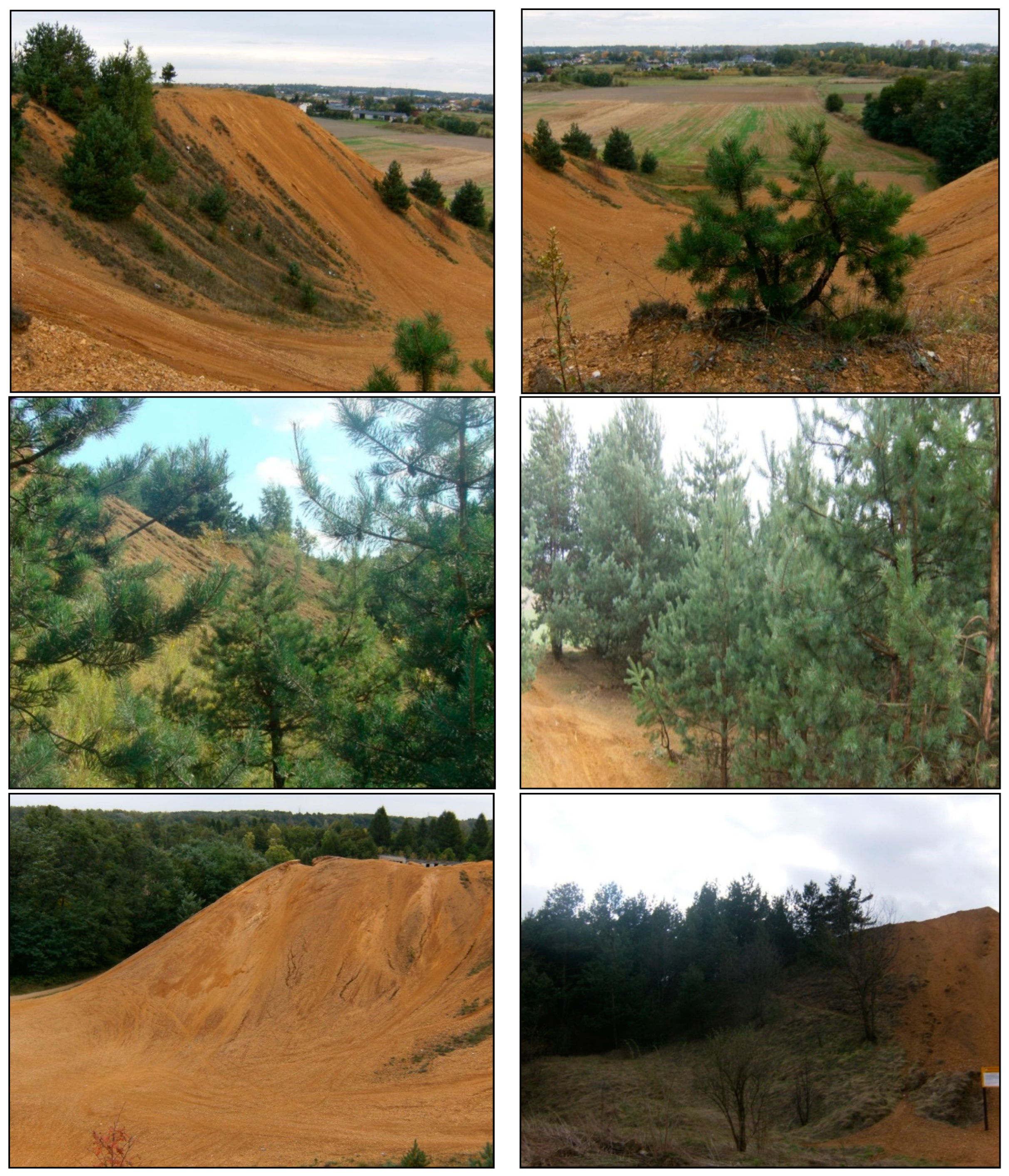
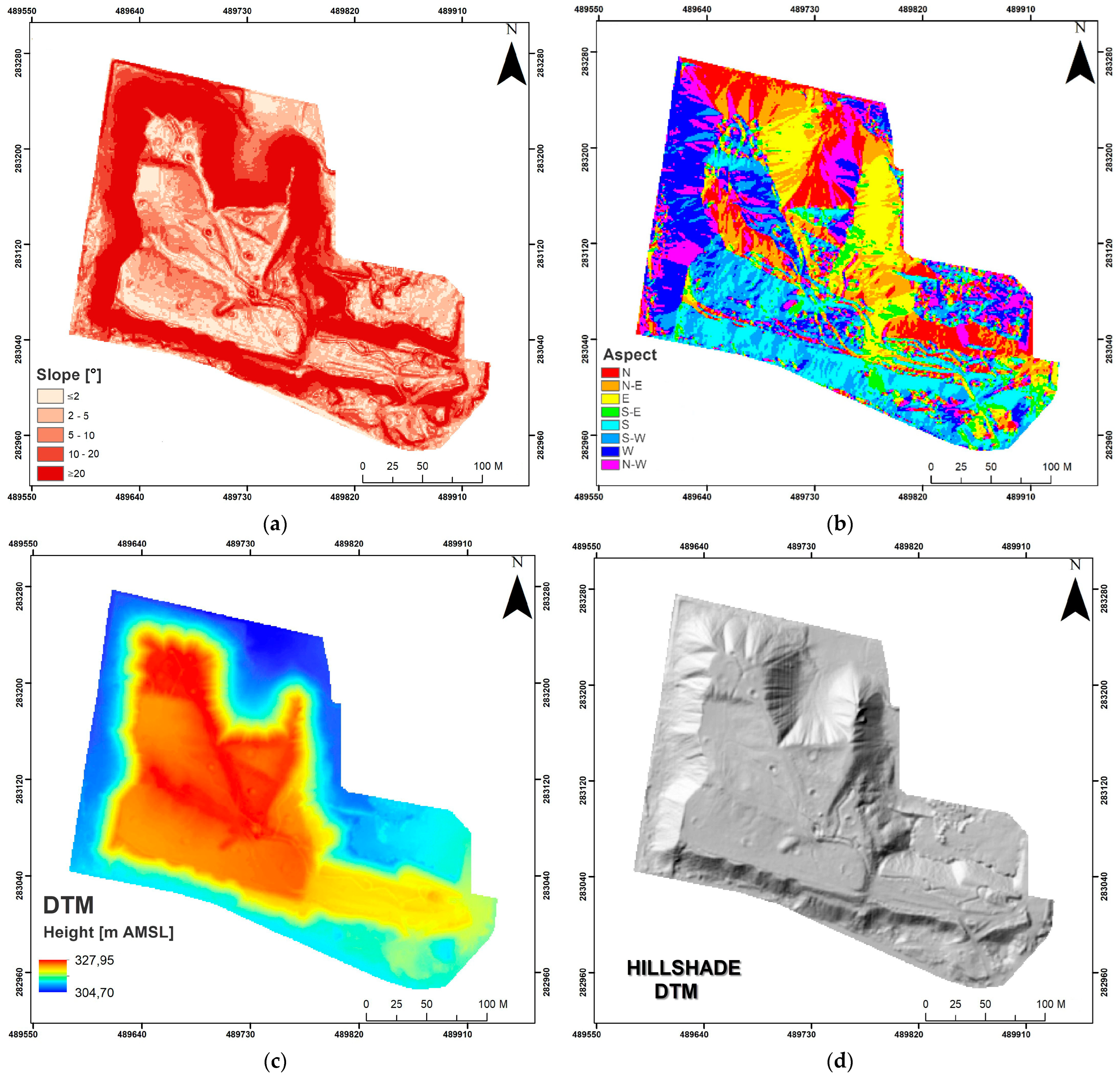


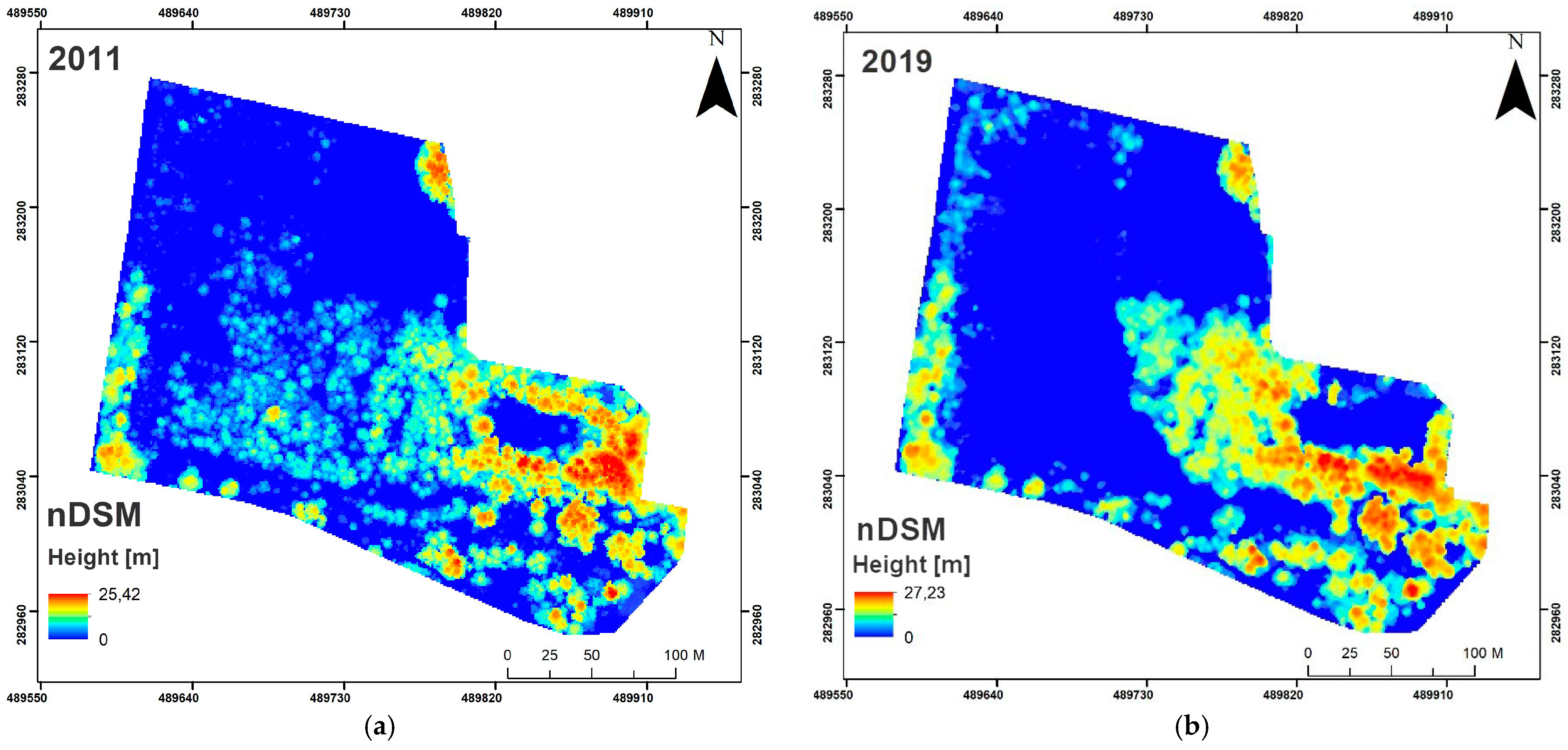
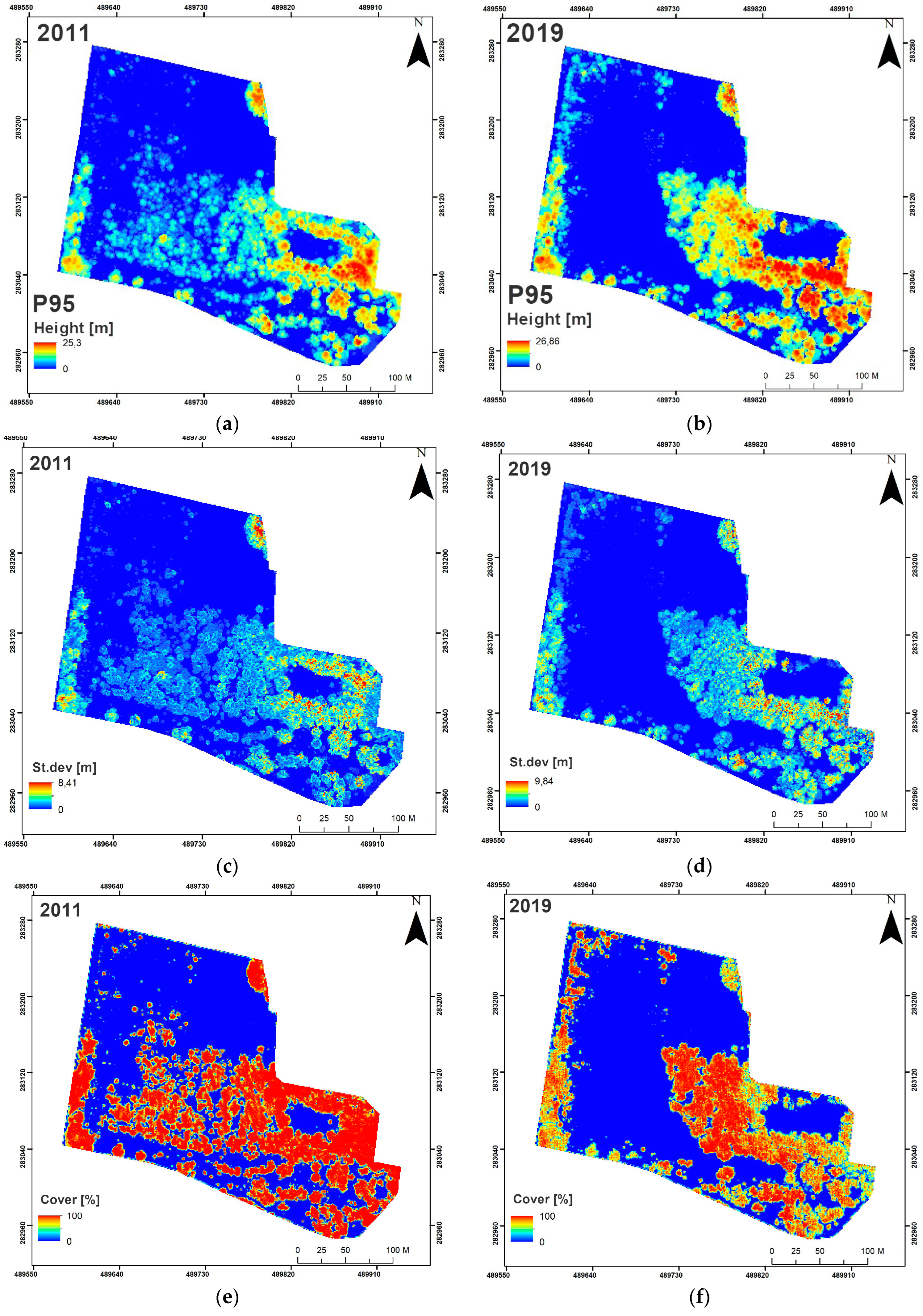
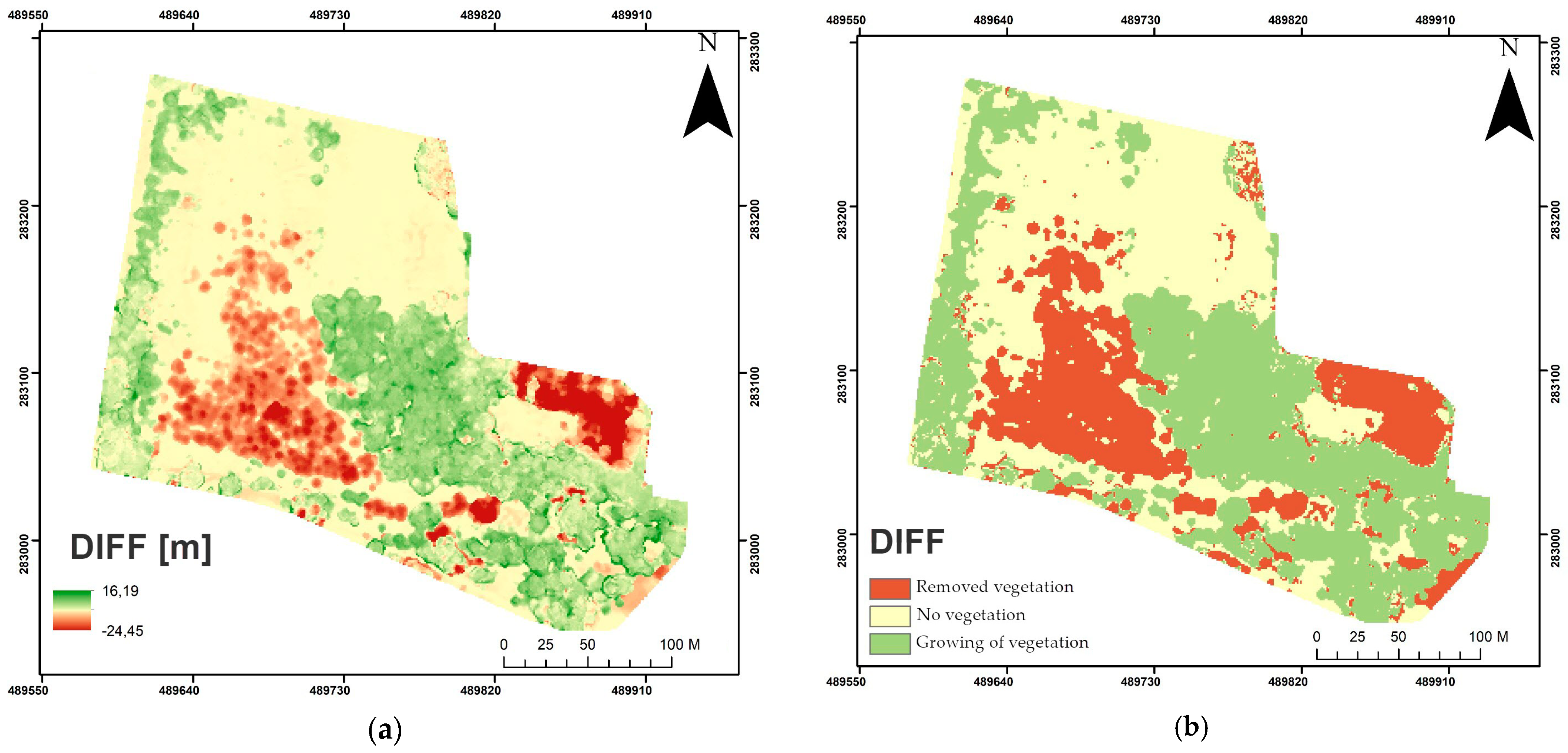
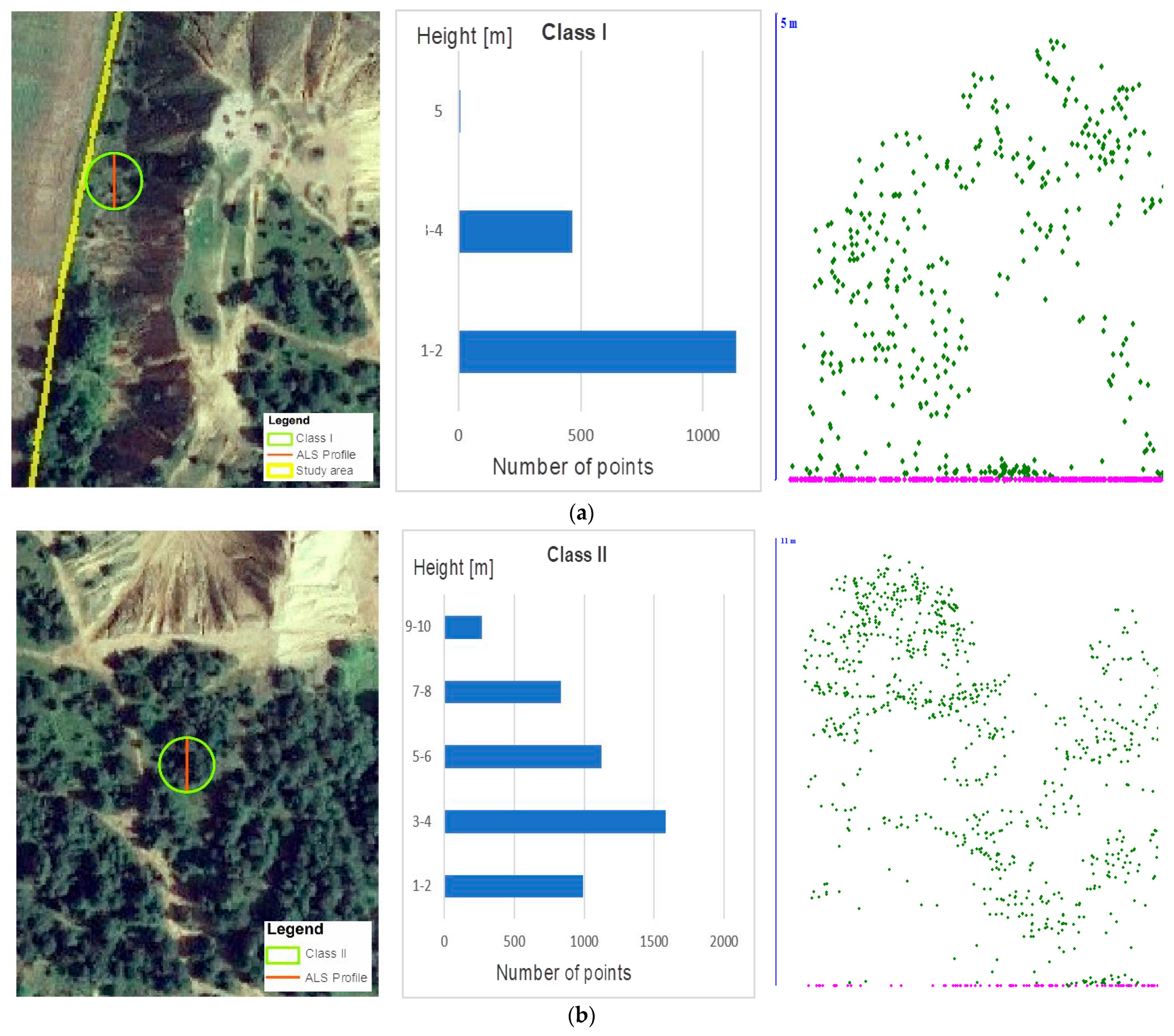

| Year | Height [m] | Std. dev. of Height [m] | Canopy Cover [%] |
|---|---|---|---|
| 2011 | 6.84 | 0.68 | 30.0 |
| 2019 | 8.41 | 0.86 | 42.0 |
| Year | Volume [m3/%] | Increase in Volume of Vegetation [m3/%] | Loss of Vegetation Volume [m3/%] |
|---|---|---|---|
| 2011 | 310,558 m3—100.0% | 99,880 m3—32.1 % | 85,136 m3—27.4 % |
| 2019 | 325,266 m3—104.7% |
| Classes | Year | Mean Height [m] | Std. dev. of Height [m] |
|---|---|---|---|
| Low vegetation (class I) | 2011 | 0.82 | 0.14 |
| 2019 | 3.31 | 0.74 | |
| Medium vegetation (class II) | 2011 | 4.75 | 0.97 |
| 2019 | 8.95 | 1.56 | |
| High vegetation (class III) | 2011 | 15.96 | 2.46 |
| 2019 | 16.70 | 3.86 |
Disclaimer/Publisher’s Note: The statements, opinions and data contained in all publications are solely those of the individual author(s) and contributor(s) and not of MDPI and/or the editor(s). MDPI and/or the editor(s) disclaim responsibility for any injury to people or property resulting from any ideas, methods, instructions or products referred to in the content. |
© 2022 by the authors. Licensee MDPI, Basel, Switzerland. This article is an open access article distributed under the terms and conditions of the Creative Commons Attribution (CC BY) license (https://creativecommons.org/licenses/by/4.0/).
Share and Cite
Szostak, M.; Pająk, M. LiDAR Point Clouds Usage for Mapping the Vegetation Cover of the “Fryderyk” Mine Repository. Remote Sens. 2023, 15, 201. https://doi.org/10.3390/rs15010201
Szostak M, Pająk M. LiDAR Point Clouds Usage for Mapping the Vegetation Cover of the “Fryderyk” Mine Repository. Remote Sensing. 2023; 15(1):201. https://doi.org/10.3390/rs15010201
Chicago/Turabian StyleSzostak, Marta, and Marek Pająk. 2023. "LiDAR Point Clouds Usage for Mapping the Vegetation Cover of the “Fryderyk” Mine Repository" Remote Sensing 15, no. 1: 201. https://doi.org/10.3390/rs15010201







